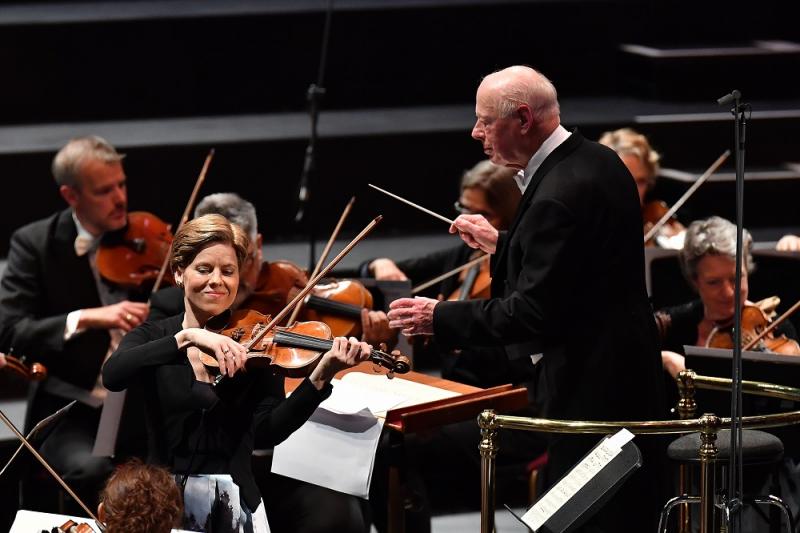
 United Kingdom 2017 BBC PROMS 3 – Mozart, Schumann: Isabelle Faust (violin) Chamber Orchestra of Europe / Bernard Haitink (conductor) Royal Albert Hall, London. 16.7.2017. (GD)
United Kingdom 2017 BBC PROMS 3 – Mozart, Schumann: Isabelle Faust (violin) Chamber Orchestra of Europe / Bernard Haitink (conductor) Royal Albert Hall, London. 16.7.2017. (GD)

Mozart – Symphony No.38 in D major, K.504 ‘Prague’; Violin Concerto No.3 in G major K.316
Schumann – Symphony No.2 in C major, Op.61
For an eclectic ‘all round’ conductor who, now in his late eighties, concentrates mainly on the great Austro-German classics, Haitink has conducted very little Mozart. He recorded the three Da Ponte operas when he was music director at Glyndebourne in the mid to late eighties, which, although well sung, had none of the finesse, contrast and sense of drama and ironic comedy, so essential to Mozart. He also recorded a rather marmoreal Die Zauberflöte from Bavarian Radio. And as far as I know, apart from a couple of the late Piano Concerti, he has not recorded any of the Mozart symphonies, apart from a ‘live’ performance of the ‘Prague’ Symphony from Dresden with the Staatskapelle. He has very occasionally played some the late symphonies in concert, but those I have heard – K.543 and K.551 (the so-called ‘Jupiter’ Symphony) were quite forgettable.
Haitink conducted a well-crafted performance of the ‘Prague’, The D minor intrusions of the long introduction, anticipating, the D minor tone of Don Giovanni and the Don’s demonic fate, made their dark and impressive effect, although here, and throughout the performance, I wanted more of a sharp edge, especially from brass and timpani. The main Allegro was swift with elegant phrasing, and, thankfully, a minimum of vibrato. In one sense, this performance was a kind of fusion of the old-fashioned Mozart, with a largish orchestra, and the more Mozartian sounding period style. A commentator who knew Mozart wrote of a Prague performance he heard that it was played (Mozart directing) ‘with great panache, brio and fire, so that the very soul is carried to sublime heights’. When Haitink reached the complex development section, with its double fugue, I heard very little ‘fire’ or sense of the ‘sublime’, so tellingly heard, achieved by the likes of Harnoncourt and Adam Fischer.
The G major Andante, anticipating the mood of ‘Della sua pace’ in Don Giovanni, benefitted from being played as a real Andante. Haitink, with superb playing from the COE, achieved a nice flowing sense of movement, although the darker tonalities of the quasi development, with contrapuntal cross-over chords, achieving a rich harmonic palette, needed sharper delineation and drama. The Presto finale, with its swift motion and unencumbered grace – with an opening directly related to the whispered Duettino between Susanna and Cherubino in Act II of Figaro – went quite well, although again, I found the more dramatic music in the quasi development section under-powered, lacking those sharp accents, especially from trumpets and timpani, well played, but curiously toned down? Haitink observed the initial repeats in the two outer movements, and the Andante.
K.216 is probably the most played of Mozart’s violin concertos, although few realise that it is one of those rare occasions were Mozart borrows from another work, his recent opera Il re pastore, based on a libretto which tells of an unlikely mix up in the desire for a shepherd, who is in reality of royal blood. And this mood of buffo comedy and a more mock serious tone permeates the first movement. Isabelle Faust turned in a splendid performance, intoning every phrase/inflection of the first movement with a real sense of contrast in the alternation between forte and piano, again reminiscent of some of the arias in II re pastore. In the Adagio Faust was particularly impressive in the way she soared above the serenade-like pizzicato in the lower strings. The Mozart scholar Alfred Einstein famously described this movement as ‘falling straight from heaven’. This might sound too romantic to modern – or post-modern ears – but it still somehow captures Mozart’s talent for serene melodic perfection which was his alone. The Rondo finale with its opening joyous theme in 3/8 time and its serenade tune (Andante), actually sounding like a guitar with pizzicato strings, and its wonderful fade away coda, were all fully realised and relished by Faust. She played cadenzas by Andreas Staier. Haitink accompanied well, although, as in the symphony, I wanted a shade more rhythmic sharpness and bounce to match Faust’s superb rendition.
Today Schumann’s Second Symphony is seen as the symphonic masterpiece it is, and is played regularly in concert, although the Fourth Symphony is still played more. I mention this because as tonight’s programme tells us, this was not always the case. The eminent music critic Mosco Carner, writing in the early fifties, called the symphony a ‘pathetic failure’, ‘laborious and dull’. Carner saw Schumann’s mental deterioration as the main cause for this failure. It is striking to observe how far we have come! Today we see much more clearly that mental disorders (in Schumann’s case what we would now call bi-polar disorder) actually help facilitate the creative process, which is so true in Schumann’s case. As the composer acknowledged, this work is full of the tones (moods) of light and darkness, a kind of ever intense dialectic of two powerful forces. The very opening Sostenuto assai determines the dark battle waged throughout the symphony, expressing light, with sonorities in the trumpets and horns, and darkness, particularly in the counterpoint of the strings and a dark pianissimo.
Haitink conducted a mostly fine performance, with particular focus on the works symphonic structure. And again, the COE played with great distinction. But by the time we reached the dramatic and extended development section of the first movement, where a tremendous conflict ensues – the opening E flat transmogrifying into a constellation of minor key dissonances – then a battle of major and minor, all this did not really register. It was all accurately played, but failed to inflect this conflict of themes and tonal registers. Conductors of the past who championed this work – Toscanini, Reiner, Szell – played this drama of conflict with staggering conviction, but it all seemed alien to Haitink. The brief Scherzo, does not let up. Restlessness and uncertainty are the main characters of this internal drama. With Haitink this restless energy was curiously lacking, only the two contrasting trios, with slightly mock humour, seemed to register any sense of empathy from the conductor.
Haitink came into his own in the C minor Adagio espressivo shaping every phrase with compelling sensitivity. The beautiful solos for oboe, clarinet and bassoon, were all lovingly contoured, as was the intimate and intricate fugato section. With such mastery of orchestration, it is astounding to think that for years Schumann was seen as a second-rate orchestrator, or worse.
The finale was mostly a success, with the motive of light shining out in the triumphant coda with jubilant brass fanfares. The occasional recollection of the earlier melancholy and conflict, could have been emphasised more, as could the basic shift from a minor key soundscape to a major key register in the second subject, also the inversion of the main Adagio theme towards the blazing coda. But overall the movement was a success with some superb brass playing, complimenting the all-round excellence of orchestral playing.
As an encore, Haitink gave us a rather sedate rendition of the Scherzo from Mendelssohn’s incidental music to A Midsummer Night’s Dream. The Prom audience loved it, stamping, and cheering for more…
Geoff Diggines
For more about the 2017 BBC Proms click here.

What a mean-minded review! Great music can be played in any number of ways, and Bernard Haitink’s level-headed geniality is as valid as any other. Perhaps Geoff Diggines would be happier staying at home and listening to his CDs. I suspect that most people in the audience would say that this Prom was a delight.
As I wrote elsewhere: ‘We know there are lots of readers of Seen and Heard out there and we are sure you do not always have the same opinion as our reviewers. It is always good when we get feedback with your reactions to the opera, concerts or reviews.’ You obviously have one opinion of the concert and Geoff has another. Did you go to the concert? ‘Mean-minded’ is a little harsh for a quite positive review about the soloist, COE and the Schumann.
I stood in the arena for this Prom during a recent visit to London. Your headline ‘All-round excellence from the COE and Isabelle Faust under the ageless Haitink’ doesn’t really reflect the review itself. Yes, it has positive things to say about the quality of the playing, but there are several disparaging remarks about Bernard Haitink’s conducting: ‘I wanted more of a sharp edge . . . I heard very little “fire” or sense of the “sublime” . . . needed sharper delineation and drama . . . under-powered . . . curiously toned-down . . . this drama of conflict all seemed alien to Haitink . . . with Haitink this restless energy was curiously lacking’. Geoff Diggines seemed to want to hear his preferred CD interpretations reproduced at the concert, and was unhappy when Bernard Haitink gave us something different: warm, life-affirming performances imbued with a lifetime’s experience of music-making.
I was not there but note another reviewer bemoaning the lack of ‘drama’ and ‘darker undercurrents’ in Haitink’s Mozart and a lack of Dionysian quality to his Schumann. I think this is a case of your opinion differing from Geoff’s (and that other reviewer) and this happens with performances of classical music.